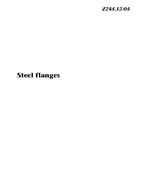CSA Z245.12-05
Click here to purchase
Preface
This is the fifth edition of CSA Z245.12, Steel flanges.
It supersedes the previous editions published in 2001, 1996, 1991, and 1985.
This Standard covers the requirements for steel flanges intended to be used for transporting fluids as specified in CAN/CSA-Z662, Oil and Gas Pipeline Systems.
1 Scope
1.1 General
This Standard covers wrought steel flanges primarily intended for use in oil or gas pipeline systems.
1.2 Size, grade, nominal pressure class, and category
1.2.1 SizeThis Standard covers flanges in sizes from NPS 1/2 to NPS 60. (See Table A.1.)
1.2.2 GradeFor other than sour service, this Standard covers flanges from Grade 248 to Grade 550. For sour service, this Standard covers flanges from Grade 248 to Grade 483.
Note: The standard grades are Grades 248, 290, 317, 359, 386, 414, 448, 483, and 550; however, intermediate grades may also be used.
1.2.3 Nominal pressure classThis Standard covers flanges having cold working-pressure ratings designated by nominal pressure classes from PN 20 to PN 420. The standard nominal pressure classes are shown in Table 1. (ASME class designations are shown in Table B.1.)
1.2.4 CategoryThis Standard covers flanges in the following categories:(a) Category I: flanges without requirements for proven notch-toughness properties; and(b) Category II: flanges with requirements for proven notch-toughness properties.
1.3 AssembliesThis Standard does not cover assemblies. Note: An assembly is a grouping of fittings or flanges, or both, joined by one or more circumferential welds.
1.4 TerminologyIn CSA standards, “shall” is used to express a requirement, i.e., a provision that the user is obliged to satisfy in order to comply with the standard; “should” is used to express a recommendation or that which is advised but not required; “may” is used to express an option or that which is permissible within the limits of the standard; and “can” is used to express possibility or capability.Notes accompanying clauses do not include requirements or alternative requirements; the purpose of a note accompanying a clause is to separate from the text explanatory or informative material.Notes to tables and figures are considered part of the table or figure and may be written as requirements. Annexes are designated normative (mandatory) or informative (non-mandatory) to define their application.
Product Details
- Published:
- 10/25/2005
- Number of Pages:
- 66
- File Size:
- 1 file , 660 KB
